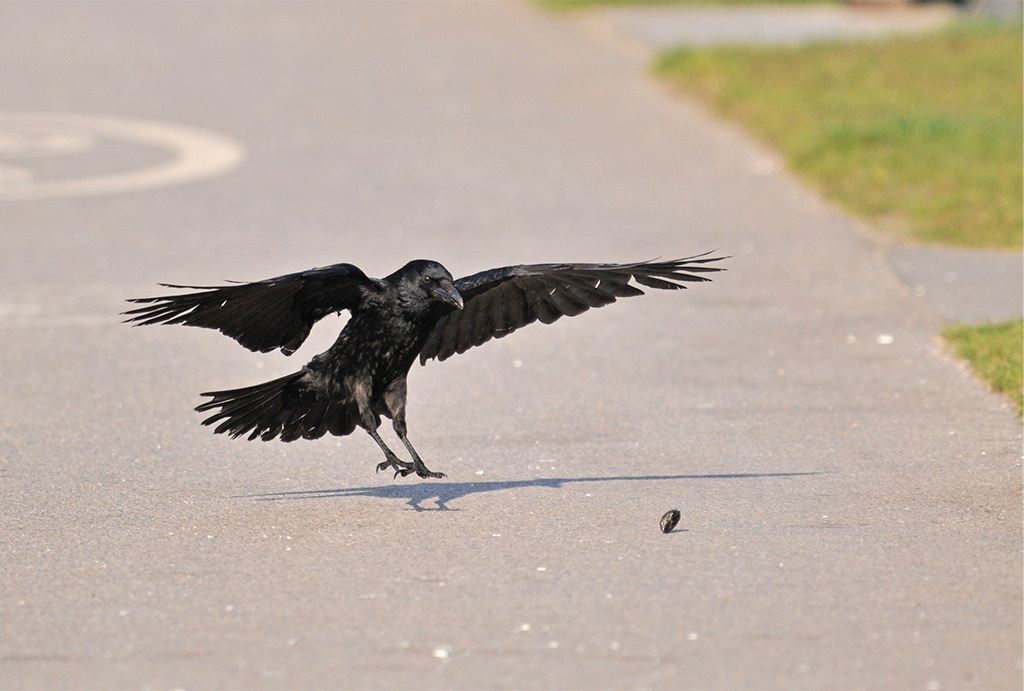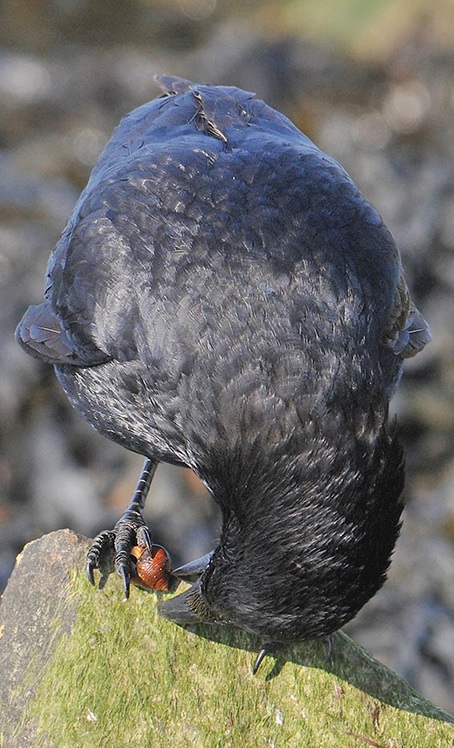Cycling to work along Baiter, I had noticed a flock of crows. Normally a ‘flock’ is an identification feature for Rooks while ‘not in a flock’ identifies Carrion Crows. So this little gathering caught my attention. It seemed as if these Carrion Crows were standing on the grass around the cycleway, waiting for the tide to turn so they could go fishing for winkles and cockles. Then they would fly up and drop the shells onto the tarmac to break them. Lately, the cycle path had been getting very crunchy to ride on.
Around the same time, Stephen Moss (author, columnist and birder) was one of the two producers responsible for coordinating the various live strands of Autumnwatch, the BBC TV programme that at that time starred Bill Oddie. The programme was to be based on Brownsea Island, and as part of Stephen’s research he had contacted me. Over breakfast at The Sandbanks Hotel, I gave him a digest of interesting bird things that happen here in late autumn. Almost as an afterthought, I mentioned the cockling Carrion Crows.
Stephen sent his team in to film them. When the sequence was broadcast the next evening, Bill was chatting away to the camera when he mentioned that it was the first time he had seen Carrion Crows cockling. Intrigued, I looked it up in Witherby et al’s The handbook of British birds (1938-41), which stated that the “Habit of smashing molluscs, crabs, … and other hard-shelled articles of food from a great height is well known.” So I hadn’t made a new discovery.

Carrion Crow Corvus corone, Balter car park, Poole, Dorset, 12 April 2010 (Nick Hopper). Dropping shells on tarmac.
Why had both Bill and I missed this behaviour before? It’s probably because they are still recovering from the most severe persecution of any of our native birds. All the corvids were shot, poisoned or trapped routinely. Carrion Crow numbers have now recovered dramatically, with very few of us noticing. Between 1964 and 1977, Carrion Crow numbers in Britain doubled and in the 30 years since then, with a decline in shooting and trapping, no doubt they have doubled again. This means that we are seeing behaviour like cockling that was probably common in Poole Harbour when numbers were higher in past centuries.
Bill has been a household name in Britain since he first appeared as a comedian in television and radio in the ‘60s. My family first met him when he stayed at our home while giving a talk for the Dorset Bird Club. My son Simon (7 at the time) was delighted and hung off his every word. The next morning when Simon hadn’t done his homework, Bill wrote him a note: “I’m sorry Simon didn’t do his homework. It was because he came to hear me give a talk. Yours, Bill Oddie.” At first the teachers thought it was just an imaginative excuse, then when they realised it was genuine they wanted to keep the note. Simon was desperate to keep it, so after some negotiation he got it back and we still have it today.
Bill stayed an extra day and we went birding at Durlston Country Park. I introduced him to Hamish Murray, who lived up to all of my stories of his canny frugality by being caught in the act of steaming an unfranked stamp off an envelope for future use. As he had the kettle on, we were able to beg a cup of tea.
Bill and I have met occasionally since then. If he was a bird he would probably be a Jay, garrulous yet elusive. I once spotted him in the summer from an office window in Carnaby Street and shouted down. Catching up on the street, I told him of one of my customers, whose ambition was to make the famous Reading football club chant ‘Bill Oddie, Bill Oddie, rub your beard on my body’ a reality. He blushed and carried on with his mission to spend his birthday money.
At the Bird Fair I’ve watched, impressed, as he does the rounds in the optics tent, asking all the binoculars and telescope companies why they can’t abandon their support for shooting interests.
On Brownsea Island, local author Dominic Couzins and I watched the rehearsals. Bill was sharp and very funny. I’m not sure who had come up with the idea of Simon King spending part of the night looking for Conger Eels off Brownsea pier. As he enthused about his task, held his mask and tipped off the boat backwards into the grey-brown soupy water of an ebb tide, they cut to footage shot earlier of an Avocet wrestling with a worm. Bill pointed out that this might be as close to a Conger Eel as the viewers would be getting this evening. Next came a man with a poem about our lives being like autumn leaves, whereupon Bill said, “And now on to a piece about feeding the birds in our gardens before we die.” None of Bill’s best jokes were in the finished programme.
Across from Brownsea, at South Haven, I’ve seen family parties of Rooks and Carrion Crows making their way into the harbour. I had often suspected that some corvids move through the harbour as winter approaches, or stay for the winter. Then one November morning while I was in London doing something important, Mo was watching a large passage of Wood Pigeon from the top of our house when she saw a single flock of 600 Jackdaws flying low over the pines of Brownsea and then west across the harbour. I was a bit gripped.

Carrion Crow Corvus corone, Baiter, Poole, Dorset, 12 April 2010 (Nick Hopper). ‘Winkling.’
It was this observation that led me to ask Nick to survey the corvids. He read Crow Country (Cocker 2007) and was inspired. We wondered if there were communal corvid roosts like Cocker described, inside the harbour. Nick worked through the autumn and winter to track down all the roosts, starting by searching out the rookeries. Visiting Studland on winter afternoons, he discovered what looked like a roost at the edge of Greenlands farm. He watched the large numbers of birds that gathered in the nearby fields. As it got darker, their feeding was interspersed with short swirling flights. When it was nearly dark, the birds started to assemble in the pines on the eastern edge of the plantation, chattering away and doing little ‘dread’ flights in and out, until eventually all went quiet and Nick assumed he had found the roost.
As darkness fell, he started to walk back to his car when suddenly there was a great cacophony. The whole flock got up together and sped off into the darkness. So he still didn’t know where the roost was, and was back the next evening waiting at Goathorn, the last place he had seen them. This time his luck was in and he found the roost. It was even noisier here, with birds squabbling and jostling for position. This roost turned out to be the most impressive gathering in the harbour. In midwinter it peaked at 1,200 birds, of which 70% were Jackdaw and 30% Rooks and Carrion Crows (not easy to tell apart in the dark). Birds from Ballard and Bushey made up most of the roost. I tried to record this event, but managed to be in the wrong place at the wrong time. Then as I was answering the call of nature, this huge flock approached and I just managed a recording (CD2-78). For comparison, here are typical calls of Carrion Crow (CD2-79) and Western Jackdaw (CD2-80), also recorded in Poole Harbour.
CD2-78: Rook Corvus frugilegus and Western Jackdaw C monedula Goathorn, Poole Harbour, Dorset, England, 16:18, 18 January 2011. A mixed flock dominated by Rooks but also including a significant number of Western Jackdaws. Carrion Crows are much harder to pick out. Background: Common Blackbird Turdus merula. 110118.MC.161800.23
CD2-79: Carrion Crow Corvus corone Arne, Poole Harbour, Dorset, England, 07:00, 20 April 2008. Typical loud ‘structured calls’, an exchange between one individual close by and two or three at a distance. Carrion Crows sound more strident than Rooks, and their calls tend to be higher-pitched. Background: Common Wood Pigeon Columba palumbus, Barn Swallow Hirundo rustica, European Robin Erithacus rubecula, Common Blackbird Turdus merula, Common Chiffchaff Phylloscopus collybita and Goldcrest Regulus regulus. 08.011.MC.01645.01
CD2-80: Western Jackdaw Corvus monedula Slepe Copse, Poole Harbour, Dorset, England, 08:38, 5 May 2010. Two or three individuals at a potential breeding site. Chak calls and crowing. Background: Great Spotted Woodpecker Dendrocopos major, Eurasian Wren Troglodytes troglodytes, Eurasian Blackcap Sylvia atricapilla and Great Tit Parus major. 100502.MC.083842.01
After Nick had done a few early morning visits, it became apparent that there was also a precise ritual for leaving the roost. While still dark, the chattering and calling starts. At the first sign of any light, there would be a dramatic increase in the volume, as Jackdaws and Rooks erupt out of the roost together in a single flock and swirl around the tree tops. They would then split into groups. Jackdaws would speed ahead, with the Rooks following on at a more leisurely pace. The ‘eruption’ times were quite predictable, being triggered by light levels, with birds ‘lying in’ on mornings with a lot of cloud cover.
Nick found three more corvids’ roosts in the harbour: Upton Heath, Arne and Keysworth, and two more outside the area that were also used by Poole’s birds, one at Stony Down Plantation just north of Corfe Mullen tip, and the other a few miles up the Piddle Valley. Checking the Keysworth roost proved difficult. The owner of Keysworth wanted over 300 pounds a visit, donated to the local church. So Nick had to peep into the trees near the waterworks from across the river Piddle. This roost was unusual, as its occupancy peaked during the autumn. In mid-December a total of 1,420 Jackdaws and 685 Rooks were counted at all four main roosts. Towards the end of January, the numbers fell, and by late February numbers fell again.
To give you an idea of the recent increase in Magpie numbers, the largest known roost is at Hatch Pond. In 1995 there were 74 birds, but each year the number crept up a little. By 1 December 2008 it had reached 193, a new Dorset record. The ‘Songbird Survival Trust’ believes these rises in corvid numbers have a negative effect on farmland birds. This is a cheeky group of landed gentry and farmers who want to return to heavy control of “predators, such as cats, corvids (which include crows, jackdaws and magpies), raptors, grey squirrels, rats and foxes”. They would like to see the government controlling these ‘vermin’, and blame its reluctance in part on “relentlessly sentimental wildlife programming”. So I think it’s unlikely that any of them saw our flocks of Carrion Crows innocently feeding on cockles on Autumnwatch.
To prove their point, Songbird Survival funded a sophisticated piece of analysis that appeared in the Journal of Applied Ecology (Newson et al 2010). No doubt to their disappointment, it showed that neither Magpies nor Carrion Crows, nor indeed most of the other ‘vermin’, had played a major role in the collapse of songbird populations. So if the increase in corvids is not causing the problems facing Poole’s farmland birds, what is?